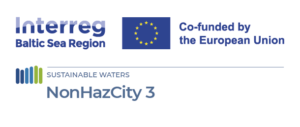Too much formaldehyde in the nurseries in Latvia
Up to 36 times more than recommended – that was the concentration of formaldehyde which was found in one of the nurseries where Baltic Environmental Forum Latvia (BEF LV) conducted air testing. Carcinogenic formaldehyde exceeded the recommended level (10 µg/m3) for sensitive people and children in 12 out of 15 tested nurseries. In four rooms the acceptable amount of formaldehyde in the indoor air exceeded ten times the allowed concentration.
“Formaldehyde irritates the mucous membranes and skin. If the concentration of this chemical is significant in the indoor air, it can affect the health of sensitive people. On average indoor air contains more than precautionary level – 20 to 40 µg/m3 of formaldehyde, but a tenfold excess isn’t acceptable,” BEF LV environmental expert Valters Toropovs says.
The main sources of formaldehyde indoors are wooden-base construction materials and furniture where formaldehyde resin adhesives have been used, some insulation materials and also textiles. More careful selection of these products and more diligent ventilation can significantly reduce the amount of formaldehyde at home.
Solvents and fragrances also pollute the air
The air in the tested nurseries also contained quite high concentrations of different organic solvents, especially toluene. The precautionary level (50 µg/m3) for this substance group was exceeded 2 to 13 times in all tested nurseries. Solvents are mainly found in various building materials such as paints, varnishes, adhesives, as well as cosmetics, household chemicals and tobacco smoke. They irritate the eyes and respiratory tract, may cause headaches and nausea.
Children’s rooms were also polluted with fragrances. The test revealed that the allergenic fragrances, e.g. limonene, pinenes exceeded the recommended concentration (30 µg/m3) 2 to 8 times in 11 out of 15 rooms. “Fragrances are also irritants. In some cases they can cause allergies. It is estimated that 1 % to 3% of the European population are allergic to one or another fragrance. Since the main sources of fragrances are household chemicals and cosmetics, parents should think whether they aren’t overusing those products,” ValtersToropovs continues.
The air in the nurseries isn’t good enough
Overall, the test results showed that the quality of the air was satisfactory for children only in 2 nurseries out of 15. It should be emphasized that children are especially sensitive to chemicals because they adsorb 40% more hazardous substances than adults. The total amount of harmful substances in the air of other 13 rooms was above the recommended level of 300 µg/m3.
“Although we didn’t find the indoor air to be dramatically poor , the precautionary level was exceeded. In order to improve the air quality parents should ventilate the rooms more often – they should open the windows at least twice a day for five minutes. It really helps. The real life examples are some of the tested rooms. After receiving results with high levels of harmful substances parents increased the ventilation and hence reduced the pollution at homes,” Valters Toropovs suggests.
It’s also worth to remember that less is better – the fewer things mean less potential pollution sources in the children’s room. Parents shouldn’t pollute the air with fresheners, perfumes, excessive cleaning or sudden repair works. They should also think before they choose furniture or other equipment for the nursery. Preference should be given to natural materials. Parents should read the labels and warnings on the product and shouldn’t hesitate to ask the retailers or producers about harmful substances, e.g. formaldehyde in their products.
15 tested nurseries were selected from 130 voluntarily applied rooms all across Latvia. 40 different harmful substances were tested in the collected air samples. Air testing was carried out in cooperation with accredited laboratory Vides audits.
Notes:
- Precautionary concentration levels are form Guidelines for ventilation requirements in buildings (1992, EC Directorate General for Science, Research and Development, Joint Research Centre, Environment Institute), WHO Guidelines for indoor air quality – selected pollutants (2010).
- Only 40 harmful substances were tested in the air testing activity therefore the total level of chemicals can be higher in the nurseries
- µg/m3 – micrograms of substance per cubic meter of air

